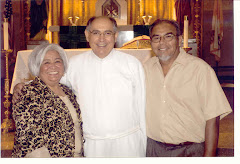
He is one of the principal angels. His name was a war-cry of the
good angels in the war against the evil one and his followers St. Michael is spoken of in the book of Revelations 12:7-8, and there was war in heaven. Michael and his angels fought against the dragon, and the dragon and his angels fought back. But he was not strong enough, and they lost their place in heaven. The great dragon was hulrd down--that ancient serpent called the devil, or Satan, who leads the whole world astray. He was hurled to the earth, and his angels with him.
It is St. Michael's prayer, at the left, that is given to us as a strong prayer against the evil one.
God Himself has asked us to pray this prayer daily in True Life in God. It is the same source that gives us the words of St. Michael as spoken to Vassula Ryden...
"Daughter of the Most High, allow Me to tell God's children that they should pursue Peace: "Who among you delights in Life? Then come closer to the Holy One and never give Him up....stand firm forever....how blessed are those whose God is Yahweh! They are the heirs of His Kingdom! I tell you, friends of the Christ,today Christ is wearing sackcoth to manifest His grif....for the sake of His Love, fast this Friday on bread and water to relieve His Heart; offer Christ this sacrifice; I have indeed called lyou here to honor the Most High and I, the Archangel, Saint Michael, am mightily touched by your visit; My hands are in full battle and My arm is constantly raised to keep evil away....pray to Me as you do and encourage others too, to do the same; The Enemy of God weakens with this prayer; 1 praise God and no one else; Lift your heads to God and to no one else; Lov eGod with all your heart and soul; So not fall into temptations; Ponder on all the good things you receive from the Most High and Bless Him; and now come and visit, Me again; I Love You;"
Saint Michael, God's Archangel
Prayer
St.MichaelThe Archangel, defend us in the day of battle, be our safeguard against the wickedness and smares of the devil. May God rebuke him, we humbly pray, and do Thou, The Prince of the Heavenly Host, by the power of God, cast into hell, satan and all the evil spirits who prowl the earth seeking the ruin of souls. Amen.
















